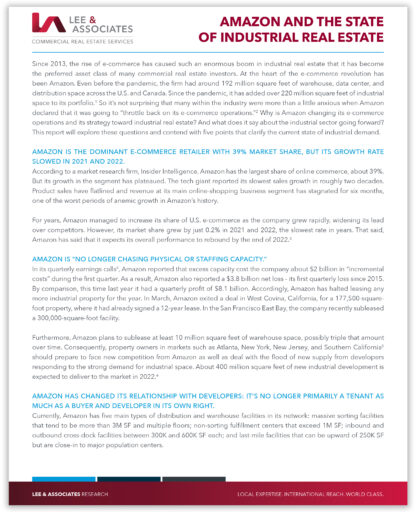Amazon and the State of Industrial Real Estate
 Since 2013, the rise of e-commerce has caused such an enormous boom in industrial real estate that it has become the preferred asset class of many commercial real estate investors. At the heart of the e-commerce revolution has been Amazon. Even before the pandemic, the firm had around 192 million square feet of warehouse, data center, and distribution space across the U.S. and Canada. Since the pandemic, it has added over 220 million square feet of industrial space to its portfolio.1 So it’s not surprising that many within the industry were more than a little anxious when Amazon declared that it was going to “throttle back on its e-commerce operations.”2 Why is Amazon changing its e-commerce operations and its strategy toward industrial real estate? And what does it say about the industrial sector going forward? This report will explore these questions and contend with five points that clarify the current state of industrial demand.
Since 2013, the rise of e-commerce has caused such an enormous boom in industrial real estate that it has become the preferred asset class of many commercial real estate investors. At the heart of the e-commerce revolution has been Amazon. Even before the pandemic, the firm had around 192 million square feet of warehouse, data center, and distribution space across the U.S. and Canada. Since the pandemic, it has added over 220 million square feet of industrial space to its portfolio.1 So it’s not surprising that many within the industry were more than a little anxious when Amazon declared that it was going to “throttle back on its e-commerce operations.”2 Why is Amazon changing its e-commerce operations and its strategy toward industrial real estate? And what does it say about the industrial sector going forward? This report will explore these questions and contend with five points that clarify the current state of industrial demand.
AMAZON IS THE DOMINANT E-COMMERCE RETAILER WITH 39% MARKET SHARE, BUT ITS GROWTH RATE SLOWED IN 2021 AND 2022.
According to a market research firm, Insider Intelligence, Amazon has the largest share of online commerce, about 39%. But its growth in the segment has plateaued. The tech giant reported its slowest sales growth in roughly two decades. Product sales have flatlined and revenue at its main online-shopping business segment has stagnated for six months, one of the worst periods of anemic growth in Amazon’s history.
For years, Amazon managed to increase its share of U.S. e-commerce as the company grew rapidly, widening its lead over competitors. However, its market share grew by just 0.2% in 2021 and 2022, the slowest rate in years. That said, Amazon has said that it expects its overall performance to rebound by the end of 2022.3
AMAZON IS “NO LONGER CHASING PHYSICAL OR STAFFING CAPACITY.”
In its quarterly earnings calls4, Amazon reported that excess capacity cost the company about $2 billion in “incremental costs” during the first quarter. As a result, Amazon also reported a $3.8 billion net loss – its first quarterly loss since 2015. By comparison, this time last year it had a quarterly profit of $8.1 billion. Accordingly, Amazon has halted leasing any more industrial property for the year. In March, Amazon exited a deal in West Covina, California, for a 177,500-square-foot property, where it had already signed a 12-year lease. In the San Francisco East Bay, the company recently subleased a 300,000-square-foot facility.
Furthermore, Amazon plans to sublease at least 10 million square feet of warehouse space, possibly triple that amount over time. Consequently, property owners in markets such as Atlanta, New York, New Jersey, and Southern California5 should prepare to face new competition from Amazon as well as deal with the flood of new supply from developers responding to the strong demand for industrial space. About 400 million square feet of new industrial development is expected to deliver to the market in 2022.6 READ MORE >
